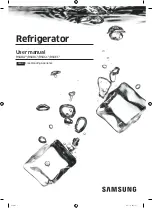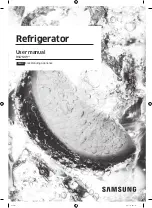
7
Install New Water Line
(if required)
TOOLS NEEDED: Flat-blade screwdriver,
⁷⁄₁₆
" and
¹⁄₂
" open-end
wrenches or two adjustable wrenches,
¹⁄₄
" drill bit, hand drill or
electric drill (properly grounded).
1. Turn OFF main water supply. Turn ON nearest faucet long
enough to clear line of water.
2. Find a
¹⁄₂
" (12.70 mm) to 1
¹⁄₄
" (3.18 cm) vertical COLD water
pipe near the refrigerator.
NOTE: Horizontal pipe will work, but the following procedure
must be followed: Drill on the top side of the pipe, not the
bottom. This will help keep water away from the drill. This also
keeps normal sediment from collecting in the valve.
3. Determine the length of copper tubing you need. Measure
from the connection on the lower left rear of refrigerator to the
water pipe. Add 7 ft (2.1 m) to allow for cleaning. Use
¹⁄₄
"
(6.35 mm) O.D. (outside diameter) copper tubing. Be sure both
ends of copper tubing are cut square.
4. Using a grounded drill, drill a
¹⁄₄
" (6.35 mm) hole in the cold
water pipe you have selected.
5. Fasten shutoff valve to cold water pipe with pipe clamp. Be
sure outlet end is solidly in the
¹⁄₄
" (6.35 mm) drilled hole in the
water pipe and that washer is under the pipe clamp. Tighten
packing nut. Tighten the pipe clamp screws carefully and
evenly so washer makes a watertight seal. Do not overtighten
or you may crush the copper tubing, especially if soft (coiled)
copper tubing is used. Now you are ready to connect the
copper tubing.
6. Slip compression sleeve and compression nut on copper
tubing as shown in the diagram. Insert the end of the tubing
into the outlet end of the shutoff valve as far as it will go.
Screw the compression nut onto the outlet end with an
adjustable wrench. Do not overtighten.
7. Place the free end of the tubing into a container or sink, turn
ON main water supply and flush out tubing until water is clear.
Turn OFF the shutoff valve on the water pipe.
Install Custom Door Panels
1. Remove any packing tape.
2. Remove the refrigerator and freezer door trims from the hinge
side of each door by pulling the trim away from the bottom of
the door first.
3. Partially unscrew the two screws that hold the top trim in
place. It is not necessary to completely remove the screws.
Loosen the screws at least
¹⁄₄
" (6.35 mm) from the trim to allow
the panels to slide freely.
4. Remove the existing door panels, if panels were provided.
5. Slide custom door panels into place.
NOTE: The door panels may require
¹⁄₈
" (3.18 mm) cardboard
fillers behind the panels to keep them from being loose in that
area.
6. Replace the hinge side trims by inserting the notched end
under the top trim first.
7. Tighten the two top trim screws.
Connect Water Supply
1. Remove the shipping tape from the gray, coiled water tubing
on the rear of the refrigerator.
2. Before attaching copper tubing to refrigerator, flush at least
2 qts (1.9 L) of water through the copper tubing and into a
bucket to get rid of any particles in the water line.
3. Check for leaks around the saddle valve. Do not overtighten
clamp or sleeve. This will crush copper tubing.
4. Make connection to refrigerator.
Style 1: A
¹⁄₄
" x
¹⁄₄
" coupling is needed in order to connect the
water tubing to an existing household water line. Thread the
provided nut onto the coupling on the end of the copper
tubing.
NOTE: Tighten the nut by hand. Then tighten it with a wrench
two more turns. Do not overtighten.
A. Cold water pipe
B. Pipe clamp
C. Copper tubing
D. Compression nut
E. Compression sleeve
F. Shutoff valve
G. Packing nut
A
B
C
D
E
F
G
A. Side trims
B. Top trim screws
C. Door panels
D. Filler panels
A. Water tubing
B. Nut (provided)
C. Bulb
D. Coupling (purchased)
E. Ferrule (purchased)
F. Nut (purchased)
A
B
C
C
D
A
B
D
C
A
B
C
D
E
F








































